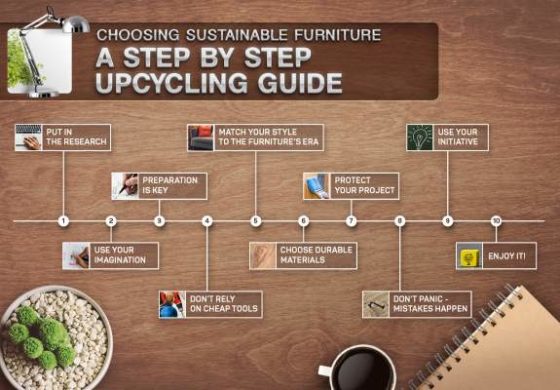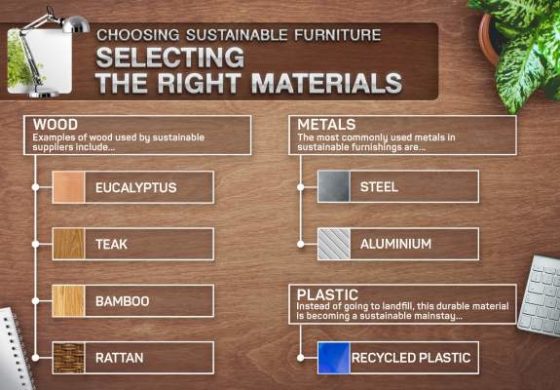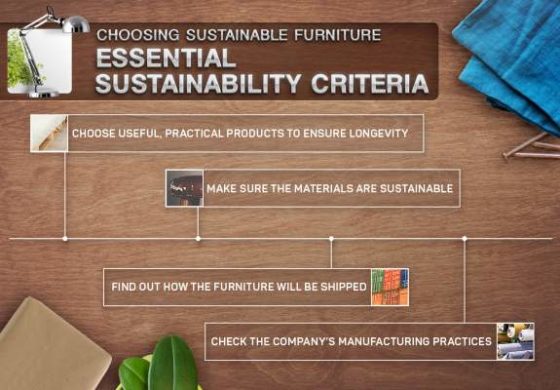A Guide To Choosing Sustainable Furniture
Tips for Upcycling and Reusing Existing Furniture
1. Put In The Research
This may seem like an obvious place to start, but many people don’t take time to learn from those with more experience. Look at sites like Pinterest and Instagram for inspiration.
2. Use Your Imagination
Think outside the box in terms of potential uses for older pieces. For instance, ladders make a stylish alternative to shelving, and old suitcases can fill in for traditional coffee tables.
3. Preparation Is Key
Make sure you have everything you need to hand (i.e. paint brushes, tools), clean and sand everything thoroughly before you begin to ensure the best possible finish.
4. Don’t Rely On Cheap Tools
While it might be tempting to opt for cheaper tools–especially paintbrushes–you’ll soon notice issues with the quality of your upcycling project.
5. Match Your Style To The Furniture’s Era
Don’t assume anything goes with your color and decorative choices–ensure you think carefully about how your chosen upcycle style matches the type and era of furniture.
6. Choose Durable Materials
If you’re decoupaging or using fabric for your project while finding the right colors/patterns is crucial, ensure you prioritize durability or you’ll be adding more work in the long run.
7. Protect Your Piece
This is especially true for wooden furniture. Make sure you wax and varnish your finished upcycle to ensure the longevity of all your hard work.
8. Mistakes Happen
It’s important not to panic if you make a mistake, odds are it’s easily fixable and you can always learn from it for next time.
9. Use Your Initiative
Even the best–laid plans come with surprises, be prepared to address challenges as they arise, and you’ll breeze through.
10. Enjoy it
This is a great excuse to get your hands dirty, take some time for yourself, and let your creativity flow.
If you follow these steps, you should be able to manage whatever the upcycling process throws at you.
Sustainable Furniture Materials
If you’re in the market for sustainable furnishings, a good first step is to look into the materials. Responsible suppliers are very clear about the materials they use and the source.
Wood
- Eucalyptus: A durable, fast-growing, and low-maintenance material effective for creating anything from sturdy cabinets to patio furniture, https://www.globosurfer.com/best-outdoor-patio-furniture/. Its use is becoming increasingly widespread.
- Teak: It may take a while to grow, but this hardy, versatile wood is great for everything. From shipbuilding to furniture and, thanks to sustainable plantations, it’s highly environmentally friendly.
- Bamboo: A grass with the sturdiness of soft steel. It’s a cost-effective, hard-wearing material with staggeringly rapid regrowth that ensures sustainability.
- Rattan: Often sold as wicker furniture, the ‘rattan’ label applies to 600 species of fast-growing palms. It is popular for their durability and guarantee of a long lifespan(indoors and out).
Metal
- Steel: A highly recyclable material with no downgrading between forms. You can reuse again, without any loss of quality, time after time. Steel furniture is one of the most durable available and its hefty lifespan ensures its sustainability.
- Aluminum: The ubiquity of this flexible metal makes it an obvious choice for sustainable furniture. It also offers a chic aesthetic that won’t leave you thinking of recycled cans.
- Plastic: Recycled Plastic: Its versatility in function and style–as well as its lengthy lifespan-has made plastic a popular choice for furniture. If you opt for a piece made from recycled plastic, you can be safe in the knowledge that you’re serious about sustainability.
These aren’t the only sustainable materials to look out for but should offer you a good starting point for your furniture search.
The Sustainable Furniture Purchasing Checklist
How Useful is the Product?
- Sustainable furniture must be useful for the buyer or user. It should offer maximum functionality, comfort, and ease of use so it isn’t in need of frequent replacement.
- Furnishings that provide greater utility for the user (i.e. multifunctional furniture like a sofabed) are always preferable. It will take up less space and effectively serve a dual purpose.
- Durability is crucial. Well-made furniture offers a longer functional lifespan which benefits the environment by not adding to the landfill.
What do I look for to ensure Furnishing Materials are Sustainable?
- If the piece has been made from materials previously used for something else that has then been reused to make a new piece of furniture, this would be classed as sustainable.
- Eco-friendly furnishings can also be made from easily renewable materials. For instance, bamboo grows quickly and rapidly, making it an ideal renewable resource.
- Ensuring you use finishes (i.e. varnishes, paints) without solvent reduces health risks in everyday use and improves sustainability.
What are the Company’s Sustainable Manufacturing Practices?
- Manufacturing practices are just as important as the materials used and must prioritize safety for the environment. This means manufacturers must check emissions and ensure their methods don’t cause pollution.
- Make sure they practice fair trade. In addition to ensuring they don’t damage local communities or undermine sensitive environments to gather materials for their products.
- For real peace of mind, it’s worth checking if they are certified by authorities such as the FSC (Forest Stewardship Council).
How was the Furniture Shipped?
- As transporting raw materials for manufacture uses energy, responsibility for low-emission transport is crucial to the production of sustainable furniture.
- If your furniture was imported, check how it was done. Products from abroad will undoubtedly expend more energy. Look for companies that transport their goods efficiently.
- To maximize your energy-efficiency, the best method is buying local furniture as this will greatly reduce your carbon footprint.
Sleeping Sustainably
Eco-consciousness can, and should, extend to the bedroom and there are plenty of options available to ensure the mattress you choose is sustainable.
Is your Mattress Eco-friendly?
To ensure you’re making the right decision, it’s crucial you research the manufacturing materials for your chosen mattress and the durability of the product as well as overall comfort to ensure a long lifespan.
Brands pioneering a more mindful approach include Silentnight, whose Eco Comfort Breathe range mattresses all contain 150 recycled plastic bottles. This helps prevent them from reaching landfill or polluting the oceans.
Recycling doesn’t just factor in the creation of the product. Remember when you’ve come to the end of your mattress’ lifecycle there are options for eco-friendly disposal. You can learn more about this here.
How will your Mattress be Transported?
When selecting your mattress, it’s worth bearing in mind how it will reach you and how this will affect the environment. For instance, roll-up mattresses (aka vacuum-packed mattresses) allow suppliers to ship a greater number in a single delivery.
This process is more efficient and reduces carbon emissions. They’re also a lot easier to get into awkward space in the home than traditional flat mattresses.
However, it’s not just the type of mattress you need to look out for. Dig into suppliers’ environmental credentials and ensure they have a commitment to making their delivery network as eco–friendly as possible.
Is your Mattress Accredited by a Trusted Organization?
A good indicator of the sustainability of a mattress (or any other piece of furniture for that matter) is whether it has the stamp of approval from a trusted environmental body.
Other suppliers with accredited products include Rest Assured, Sealy and Sleepeezee who all have products with endorsements by the Forest Stewardship Council.
Beyond environmental awareness, it’s also important to look into the comfort and health benefits a good mattress provides.
You can find a more comprehensive list of organizations to look out for here. Here are the five simple steps to clean your mattress and keep those tiny monsters out.
For related articles on living sustainably as well as how to ensure your mattress is as close to ‘zero waste’ as possible, visit the Mattress Online blog. You can also find out more about our commitment to recycling and doing our bit for the environment here.









